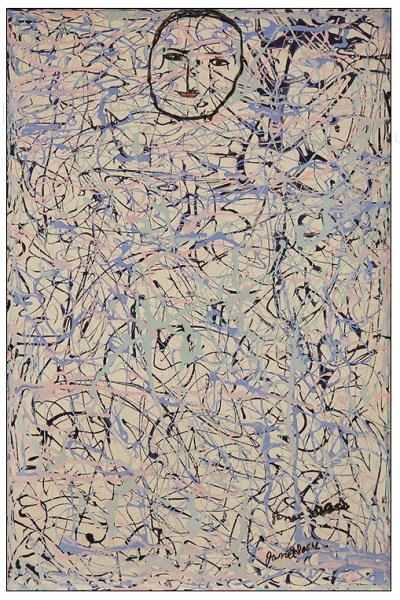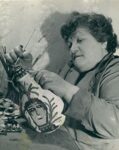
Janet Sobel
Ukrainian, 1893-1968 (active USA)
Untitled, 1946-1948 ca.
enamel paint on canvas boards
29 5/8 x19 1/4 in.

Janet Sobel - undated photo
RESEARCH PAPER
Janet Sobel's "Untitled ca. 1946-1948" is a smallish (30 x 20 inch) Abstract Expressionist drip painting. It is enamel dripped onto a canvas board primarily in pink, blue and Delft blue amorphous colors overlaying thin black lines and a white base. Toward the top of the painting, a darker iridescent blue appears on close observation to have a texture. The black lines are curved and straight and have varying widths. The primary visual elements are line and color without any space in the all-over "horror vacui" style. (Levin, pp. 5-6) There is a primitive face superimposed near the top of the piece with strong black lines depicting a woman with red lips, black elliptical eyes, eyebrows and L-shaped nose, typical of other figurative elements throughout her work The face is similar to the earlier more primitive multiple folk art faces depicting Ukrainian women in Sobel's previous surrealist paintings in which she depicted women from her childhood, but the rest of the painting is purely abstract. (Nykolak) This painting with "all-over" drippings and one figurative head may indicate that it was painted in 1946 or the shorter end of the ascribed dates since the head included is well-defined and surrounded by heavy black lines similar to those in Sobel's earlier folk images.
The artist used enamel paint from her husband's costume jewelry manufacturing company and decorated the canvas or glass bases, using a pipette to blow or drip the paint onto the base. (Nykolak) In the early 1940's her paintings were caricature-like representations of native Ukrainian peasant folk women, with oval faces circled in black lines. They progressed from full body caricatures surrounded by flowers to pieces primarily populated by heads only, with progressively more abstract images, all with oval faces, elliptical eyes and noses denoted with an L shape, always from a right side view. As her art became increasingly more abstract, she continued to include heads with the same black outlines, some with head scarfs and hats, and the same facial features. Many pieces have larger heads and some use more abstract shaped heads instead of the blacked rimmed faces. In the waning years of her more productive output, she painted a great many all-over Abstract Expressionist paintings, a few with abstract heads, and many without anything but lines and color. In 1946, Janet developed an allergy to oil paint and after 1948 painted with crayon and pencil. (Nykolak) Her main goal in painting was Visual Intensity.
Information about the artist is scarce, inconsistent, confusing, incorrect, contradictory and disappointing. The primary source is the heavily-documented 34-page paper entitled "Will the Real Janet Sobel Please Stand Up?"(Seaberg), replete with copies of original supporting documents. It attempts to correct the inaccuracies cited in the Spring-Summer 2005 article in "Woman's Art Journal 26" by Dr. Gail Levin, a New York art professor which has been cited as a source in the book "Women of Abstract Expressionism." It devotes one page to artist Sobel. The "Art History, Volume Two" by Marilyn Stokstad devotes six lines to the artist, and she is not even mentioned in many other volumes on Abstract Expressionism. Her fourth child, Sol, at age 80 was also interviewed by one author and provided valuable information. (Seaberg) Janet Sobel was primarily a housewife with an art genius which she explored in her spare time somewhat like a hobby. Her prominent family hosted many artists, such as Andre Breton and Max Ernst, the philosopher John Dewey, gallery owner Sidney Janis, all of whom admired her talent. She enjoyed only a few short years of notoriety at the time.
At approximately aged 15, Jennie Olechovsky and her mother and two brothers escaped from their village, Ekaterinoslav, near Kiev, Ukraine, after their father had been killed in a pogrom. In 2006, they arrived in the U.S. at Ellis Island, and she was given the name Jennie Wilson. Her future husband Michael Zebulsky, whom she had known since age 5, arrived around the same time. Even though their marriage certificate dated June 9, 1910, incorrectly indicates that he was 23 and she was 21, other records show that she was 17.The source of the name Sobel is a mystery unless it was an Americanization of Zebu I. Michael became Max and Jennie became Janet. The Sobel's lived in Manhattan and Brooklyn, while Mr. Sobel's jewelry manufacturing business was in Perth Amboy, New Jersey, where Janet became active as Vice-President after the death of Max in 1953. Because of the trauma of her childhood including the pogrom death of her father, a hurried escape from Ukraine, Jewish persecution and the Holocaust, some have attributed a psychological influence on her painting. Classical music was also important for inspiration and stimulation as she painted. (Nykolak)
After having five children, the shy, chubby, Jewish immigrant housewife (Gomez) began painting in 1937 when she was 44 years old. She enjoyed no formal art training, was self-taught, and there is no known artist who influenced her. It is possible that she knew of Alfaro Siqueiros, the Mexican muralist, who used a spray gun to paint murals, which is cited as the source of Jackson Pollock's knowledge of drip painting. Pollock's association with Siqueiros, which occurred in 1936 building floats for a political parade, was long before Pollock's drip period from 1947-1950 (Anirudh), yet he, not Sobel, is credited by many with inventing drip painting.
Sobel's art was first seen publicly at the Puma Gallery in N.Y. in 1944, at which time the philosopher, John Dewey, her friend, wrote: "Her work is extraordinarily free from inventiveness and from self-consciousness and pretense. One can believe that to an unusual degree her forms and colors well up from a subconsciousness that is richly stored with sensitive impressions received directly from contact with nature, impressions which have been reorganized in figures in which color and form are happily wed."(Dewey) By 1945 when her art was included in Peggy Guggenheim's The Art of the Century Gallery, the influential art critic Clement Greenberg and Jackson Pollock saw her "all-over" abstract painting, and Pollock later revealed that her art had an impact on his work. Two years later in 1947 he created his first "all-over" drip paintings.
Some of her early work included gouache on paper with scenes from her Ukrainian childhood. With encouragement from her son Sol (Solomon), an art student, she began to create folk art depicting the Ukrainian women as she remembered them. Her art progressed from Ukrainian figurative images to the full blown, highly regarded, "all-over" drip painting of Abstract Expressionism. Her primary recognition during the mid-1940's near New York art markets was affected when her family relocated to Plainfield, New Jersey, in 1947 and lived in a 23-room mansion with four mailing addresses since all her children lived there also. Janet Sobel is credited with being the originator of drip painting and an early member of the Abstract Expressionist movement, though she has been largely ignored in art history of the time. A resurgence of interest in her history is growing at the present time. Her work has appeared in five solo exhibitions and twelve group exhibitions since 2001.Two of her paintings are at the Museum of Modern Art in New York, seven are in the Crystal Bridges Museum of American Art in Bentonville, Arkansas, and manv can be found in other museums and galleries, including Gary Snyder Fine Art.
Prepared for the Santa Barbara Museum of Art Docent Council by Patricia Jones, 2020.
BIBLIOGRAPHY
Accola Greifen Fine Art. “Janet Sobel.”
http://accolagriefen.com/artists/janet-sobel
Andrew Edlin Gallery. “Janet Sobel and Pearl Blauvelt.” January 11-February 22, 2020.
https://www.edlingallery.com/exhibitions/janet-sobel-and-pearl-blauvelt
Anirudh. “10 Most Famous Paintings by Jackson Pollock” in
https://learnodo-newtonic.com/jackson-pollock-famous-paintings
Barcio, Phillip. “Shedding Light on the Drip Paintings by Janet Sobel.” January 28, 2019.
https://www.ideelart.com/magazine/janet-sobel
Dewey, John. “Janet Sobel” in Puma gallery, leaflet catalogue, New York, April24 to May 14, 1944, cited in https://en.wikipedia.org/wiki/Janet_Sobel#cite_ref-7
Gary Snyder Fine Art. “Janet Sobel” in Outsider Art Fair, 2019.
https://www.outsiderartfair.com/artists/janet-sobel
Gomez, Edward M. “Janet Sobel” in RawVision Magazine #44 (Fall 2003).
https://rawvision.com/articles/janet-sobel
KimSw. “The Forgotten Female Artist: Janet Sobel’s Struggle within the Abstract Expressionist Movement.” The Artifice, May 25, 2014.
https://the-artifice.com/janet-sobel-abstract-expressionist-movement/
Levin, Gail. “Inside Out: Selected Works by Janet Sobel.” New York: Gary Snyder Fine Art, 2003. Pp. 5-6.
Marter, Joan, ed. “Women of Abstract Expressionism.” Denver: Denver Art Museum and Yale University Press, 2016.
Museum of Modern Art, New York. “Janet Sobel.”
https://www.moma.org/artists/5503
Nykolak, Jenevive. “Janet Sobel” in National Gallery of Art, Washington, D.C.
https://www.nga.gov/features/exhibitions/outliers-and-american-vanguard-artist-biographies/janet-sobel.html
Seaberg, Libby. "Will the Real Janet Sobel Please Stand Up?”
http://www.janetsobel.com/SiteJuly24/1.html
Smith, Roberta. Art in Review: Janet Sobel. February 15, 2002.
https://www.nytimes.com/2002/02/15/arts/art-in-review-janet-sobel.html
Stokstad, Marilyn. “Art History, Volume Two, Revised Edition.” New York: Harry N. Abrams, Inc., 2017. P. 1114.
Wikipedia. “Janet Sobel.”
https://en.wikipedia.org/wiki/Janet_Sobel
